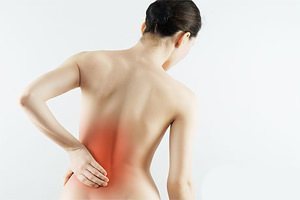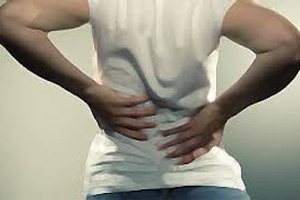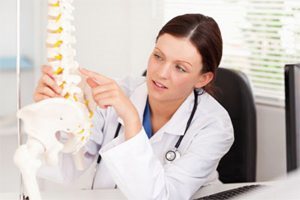Among them – lumbago, radiculitis, osteochondrosis and other pathological changes in the lumbosacral spine. It should not be treated carelessly because it is lower back pain not only can you achieve incredible strength, making the person's life unbearable, but also a symptom of dangerous diseases.
Lower back pain may take different forms: sharp or dull, aching or burning sensation, local (to view in one place) or that cover the entire back. Obvious discomfort in different ways: sometimes sharply, suddenly, and sometimes gradually, increasing with each passing day.

Response to pain and ability to tolerate it depends on many factors: age, mental characteristics, accompanying symptoms, and more. But in any case can not throw the disease of gambling. Timely treatment will help to avoid dangerous consequences.
If you want to diagnose the cause of back pain, it is necessary to review the spine and certain additional procedures: x-ray examination, computed or magnetic resonance tomography.
Attacks of pain in the lumbosacral region, is found in the life in about 80% of the modern population of the European countries. Acute or chronic back pain – the result of a variety of neurological, degenerative disease in women and men. In some cases, back pain is the result of diseases of internal organs, obesity, stress and mental disorders.
Causes of pain in the low back
The Problem of chronic pain in the low back takes the furious. The average age of onset is rapidly decreasing, the current is 35-45 years. Even in the cases of children and youth.
A prerequisite for the development of the syndrome of pain in the lower part of the back – sedentary lifestyle of modern man, which leads to a decrease in the stability of the lower back, the most vulnerable division of the skeleton. Pain can accompany many diseases, have become a common reason for seeking a neurologist, urologist, surgeon, gastroenterologist and a gynecologist. According to forecasts, further tightening of the problem. The next generation is not a healthy way of life.
Lower back pain in women
Arise in the period of gynecological diseases, or are due to the peculiarities of female physiology:
- Gynaecological diseases. Inflammation of the adnexitis, accompanied by pain in the abdomen, and sometimes pain radiating to the lower back (pain on one or both sides), it also shows the symptoms of the intimate sphere (the inability to become pregnant, long spotting before and after menstruation pain increases during sexual intercourse);
- Pregnancy;
- Menopause;
- The pain is due to an increase in suspiciousness more common in women. In-depth, comprehensive study did not reveal any pathology. This problem can occur occasionally or continuously. Psychological correction. Such pain may occur outside the influence of the menopause.
Lower back pain in men
Recurrent pain occurring in connection with the peculiarities of the professional activities of men, including, if the pain is:
- does not correspond to the physiological state of the organism of the man;
- linked to professional risks (work in cold, drafty).
Lower back pain in both men and women
Arise in connection with acute diseases of the gastrointestinal tract, surgical complications, kidney disease, metabolic disorders, diseases of infectious nature, and neoplasms (benign, malignant).
- Appendicitis. Characterized by pain localized in the right iliac region, sometimes can radiate to the lower back, usually on the right side of the body. Found indefinite pain in the lumbar region.
- Pathology of the small intestine. Accompanied by the characteristic symptoms of diseases of the gastrointestinal tract. The pain radiates to the lower back due to irritation of the fibres of the lumbar nerves.
- In the cholecystitis. Pain reminiscent of symptoms of appendicitis. Usually localized on the right side in the iliac region or in the navel. Sometimes felt in the lower back when involved in the pathogenesis fibers of the spinal nerves.
- Pancreatitis. A typical girdle pain throughout the body, in the waist, which is reflected in the lumbar. In combination with typical pancreatitis symptoms – vomiting, defecation violation, a touch on the tongue. If the cause for the pain – pancreatitis, compartment of the spine at the feeling, not reacting in response to the use of force.
- Adhesions after surgery. Occur after laparotomy or abdominal surgery on the abdominal organs, sometimes the diagnosis of congenital adhesions. The pain is localized in different parts of the abdominal wall, radiate to the lower back.
- Diseases of the kidney. Lower back pain combined with headache, increase in the diastolic (lower) threshold blood pressure, and edema. The characteristic changes in the laboratory studies, urine tests, instrumental studies, ultrasound of the kidney, MRI;
- Obesity fourth degree. This unprecedented increase muscle mass in humans. The body mass index of the fourth degree (under 25 years) = 40, the second group (25) = 41. It is defined as the ratio between the mass (in kg) double height (m). Causes pressure on the lower back, clear, without explanation.
- The infections involved in the pathogenesis of bone tissue, for example, extrapulmonary (bone) tuberculosis. Is manifested by pain in the bones. Localization of pain in the lower back is related to the fact that a massive division of the vertebral column, and this applies to maximum load. Symptoms associated with clinical picture of chronic infection. Show a slightly affordable by means of, fatigue, headache, symptoms of damage to the nervous system, the laboratory reveal the tubercle Bacillus.
- Myositis – inflammation of muscles. The muscles of the lumbar carry a heavy burden, so inflammation of the lumbar area are common. The disease develops as a result of hypothermia, penetration of the viral pathogens (herpes Zoster), bacterial infections (Staphylococcus, Streptococcus, other bacteria) in the tissue in this area. Manifested by fever, severe pain, developing suddenly after the local or General hypothermia. Chronic stage of the disease, manifested by aching pain, sometimes with the participation of the tissues of the skin and subcutaneous tissue (dermatomyositis). Diagnosis is based on clinical interviews with the patient, inspection, palpation, and laboratory methods.
- The growth of benign and malignant tumors along the nerve fibers, innervating the lower back. The symptoms are different, and correspond to the stage of the disease and localization of pathology.
Persistent and recurring back pain

There are different classifications of pain, including, depending on the duration.
- Recurrent pain usually associated with exercise, the physiological characteristics of the human body or acute diseases of the internal organs.
- Continuing acute, chronic pain, caused by irreversible pathological processes in the organism in diseases of the musculoskeletal system the human skeleton and lesions in the deep vessels of the legs.
Occasional low back pain - as they are called, because they disappear after the processing and the destruction of the source of the pain.
The origin of the pain may differ in women or men, or the same for the treatment of men and women.
Persistent back pain is usually caused by inflammatory and degenerative and irreversible degenerative processes in bone and cartilage, a serious disorder of the blood vessels in the legs. Constant pain in the less associated with damage to the muscles and internal organs.
The constant pain is called when you remove the source of the beat is difficult because the development of irreversible processes in bone and cartilage. Degenerative and dystrophic processes, which are not commonly used for complete cure. You can pause or stop it for some time. In some cases, pain persists after replacing the damaged tissue with the implant.
Recurrent and persistent pain are often closely linked to each other, so temporary pain does not become permanent.
For example, bone tuberculosis causes malnutrition of the cartilage, causing osteoarthritis, pain occurs almost always at hand, relaxation and deterioration.
Curvature of the spine (scoliosis), at first goes unnoticed, occurs occasionally, then goes into a degenerative disc disease and is manifested by constant pain. Examples can be continued.
Disease, accompanied by constant pain in the lower back:
- Lumbago – acute lower back pain. The result of the pathological changes in the lumbar vertebrae. In the initial stages the pain can be stopped as a pathological process, with timely treatment, is eliminated. Develops suddenly, lifting weights and other similar reasons. More frequently diagnosed in men. Lumbago – a possible result of a number of diseases, such as displacement, herniated disc, pinched nerve roots in the lumbar (neuralgia), inflammation or pinching of the sciatic nerve of osteoarthritis and other abnormalities of the vertebrae. In addition to severe pain, which is manifested by decreased mobility of the skeleton in the lumbar region. In the absence of treatment or incorrect treatment of lumbago can develop into irreversible disease of the bone.
- Intervertebral osteochondrosis – includes a number of diseases, which are the result of inflammatory and degenerative nature, is manifested initially by destruction of the articular surface of cartilage and bone involved in the pathogenesis of the nerves.
- Scoliosis. Sideways curvature of the vertebrae, which is manifested by asymmetry of the shoulder line, disturbance of posture, the deformation of the skeleton, the formation of rib hump, which is visible when bending. Develops, when the reduction of the function of bones and muscles, degenerative processes in the cartilage tissue of the lower back. Manifests with pain of the bones in complicated cases. Long scoliosis are asymptomatic. Scoliosis can be congenital or acquired.
- Ankylosing spondylitis loss joint mobility. Much more common in men. Another name for pathology is Bechterew's disease. Is chronic inflammation. The disease is manifested by pain in the joints and the spine, which is typical for the damage to the eyes, reduce the human growth. So is a proliferation of the connective tissue of the joints of the spine.
- Spondylosis. This is a natural process of aging joints. There is a progressive thinning and loss of mobility of the lumbar joints. Pathogenesis unfolds the complications and the accession of the inflammation with the course of the spondylosis. The symptoms are consistent with inflammation of the joints of the spine.
- Leg length difference of more than 2-3 cm, accompanied by different pain of movement, including pain in the lower back. Pathology of the develops as a muscle atrophy of one leg due to childhood polio and other diseases. In some cases, the problem of deal with the help of orthopedic tabs. The error is hard to fix when too large a difference in leg length or with a gentle lift of the leg.
- Osteoporosis – the thinning, the loss of calcium from bone tissue. Often cause hip fractures. See also lumbar osteoporosis. Manifested by deformity of the bones, joints, cartilage, development of a hernia vertebral. More common in women in menopause.
- Thrombophlebitis is a partial or complete stop of blood flow in deep veins. Combined with inflammation around the vessels. This is complicated by the disease, caused by the development of pain syndrome even at rest.
What doctor to address?

With pain in the spine in the first place to be proved, that the neurologist in the local hospital, if the patient's condition is stable, or if you want to call an ambulance. Lower back pain can be a symptom of a gynecological, urological, surgical and gastroenterological problems.
Lower back pain, often in combination with a variety of infections and injuries of the extremities. Not to eliminate pain in the lower back diseases of the heart and lungs. This is located in depth reviews.
After the patient is diagnosed, it is usually prescribed medications, which reduces pain, normalizes blood circulation and helps in restoring the nervous tissue. This can be tablets, gels, ointments or injections, relieving inflammation and cramping.
Surgical intervention is usually required for the diagnosis of a herniated disc, which is a complication of osteoarthritis. A hernia that affects the nerve roots, is removed, is restored and the pain eventually passes.
The best the spine and the muscles relax when sleeping on a hard bed, placing a knee on the small pillow. While bed rest should not last too long, because it is fraught with weakening of the muscles, that will only aggravate the problem. Even in severe pain, you should try to at least moderate physical activity.



























